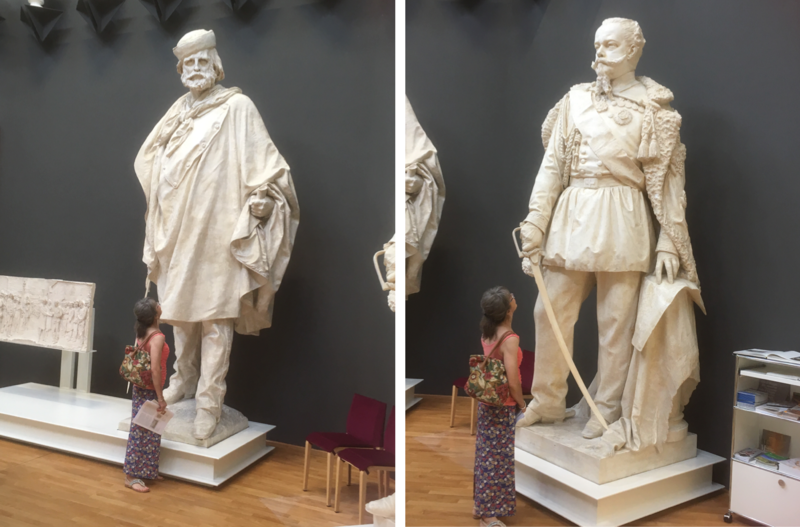I was astounded by the sheer size and beauty of the amazing sculptures that I was looking up at! To "find" this unbelievable treasure just 20 minutes from my home in the town of Ligornetto was an amazing experience.
It was a different era. A time when leaders and aristocrats commissioned sculptors to produce bronze statues and busts as monuments to their glory. A glory which would adorn town squares, villas and tombs.

@lellabird60 is dwarfed by the height of these plaster casts which were used to produce the bronze statues! On the left is Giuseppe Garibaldi an Italian general, politician and nationalist who played a large role in the history of Italy. On the right is Victor Emmanuel II who was the King of Sardinia from 1849 until 17 March 1861.

Here you can see a photo of the finished statue of Giuseppe Garibaldi as it sits in a town square paying him homage!
Who Was Vincenzo Vela?
Vincenzo Vela (May 3, 1820 - October 3, 1891) was a great artist and was renowned as one of the best sculptors of the mid-nineteenth century.
Vela was apprenticed to a stonemason while still a child and in about 1834 he joined his brother Lorenzo, also a sculptor, in Milan, where he continued his apprenticeship as a stonemason working on the Cathedral.
In 1835 he enrolled at the Brera Academy and he soon attracted attention at the competitions for the various disciplines. He finished his training as a sculptor in the studio of Benedetto Cacciatori (1793-1871).
In 1842 he won the Venice Academy competition and after finishing his studies in 1844, he started receiving public and private commissions. As of 1856 he was professor of sculpture at the Albertina Academy in Turin where his career prospered seeing him receive many major public commissions.

In Turin he operated three studios, one of which can be seen in this watercolor by Tetar Elven (1831-1908)
What Does Museo Vincenzo Vela Contain?
Vincenzo Vela made a fabulous gift to the Swiss federation by donating the magnificent house-museum and its fabulous collections through the will of his son Spartaco.
- There are approximately 5000 works conserved in the museum
- The collection of plaster casts is astounding both for their quality and size!
- Original plaster models of almost all his sculptural works are included in the collection!
- There are also terracotta and plaster preparatory models, drawings and about 1000 photographs!
- Also included in the collection are the paintings of Spartaco Vela, Vincenzo's son.
- The family library numbers more than 1500 volumes.

Here again @lellabird60 provides a scale to help us understand the colossal size of these pieces!

The realistic way that the gown drapes the woman on this statue is stunning!

The collection also includes many busts of prominent citizens of that era.

This life size work (3.84 meters high) depicts the dying Countess of D'Adda.

Here you can see small scale clay models that Vela used to plan his huge plaster then bronze statues!
The Villa Which Contains The Museum Was Built By Vela as His Private Home

This little bridge lead us over a brook and onto the property of the Villa.

We continued along the cyprus lined path on our way to the villa.

After coming from humble beginnings Vela's great success as an artist allowed him to build this impressive villa!

The grounds of the Villa are surrounded by gardens. On the right you can see a guest home.
What do You Think?
- Are you impressed by the size of some of these statues?
- Do you like to visit this type of museum?
- Do you think that men who had them created in their own honor were ego maniacs?
- Do you think that the era of this type of sculpture is long gone?
I hope that you enjoyed this article about our visit to the Vincenzo Vela Museum!
Until next time,
@kus-knee (The Old Dog)

Remember, if you upvote my post and leave a comment I will upvote it with some of my 40,000 plus Steem Power!
